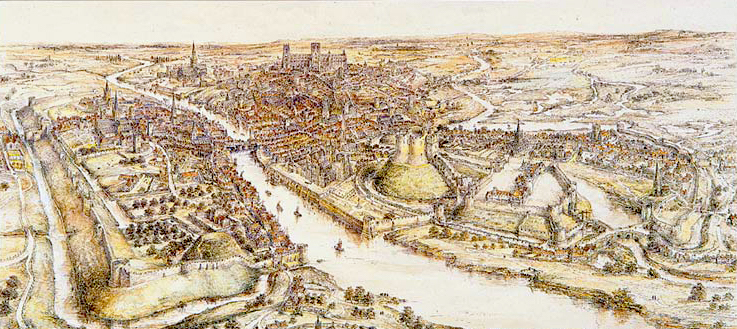Armies
Anglo-Norman warfare was characterised by attritional military campaigns, in which commanders tried to raid enemy lands and seize castles in order to allow them to take control of their adversaries’ territory, ultimately winning slow but strategic victories. Pitched battles were occasionally fought between armies but these were considered risky engagements and usually avoided by prudent commanders.

The armies of the period comprised bodies of mounted, armoured knights, supported by infantry. Crossbowmen become more numerous in the 12th century, alongside the older shortbow. At the heart of these armies was the familia regis, the permanent military household of the king, which was supported in war by feudal levies, drawn up by local nobles for a limited period of service during a campaign. Mercenaries were increasingly employed, driving up the cost of warfare considerably, and adequate supplies of ready cash became essential for the success of campaigns.
In the late 13th century Edward I expanded the familia regis to become a small standing army, forming the core of much larger armies up to 28,700 strong, largely comprising foot soldiers, for campaigns in Scotland and France. By the time of Edward III, armies were smaller in size, but the troops were typically better equipped and uniformed, and the archers carried the longbow, a potentially devastating weapon. Cannons were first used by English forces at battles such as Crécy in 1346. Soldiers began to be contracted for specific campaigns, a practice which may have hastened the development of the armies of retainers that grew up under bastard feudalism. By the late 15th century, however, English armies were somewhat backward by wider European standards; the Wars of the Roses were fought by inexperienced soldiers, often with outdated weapons, allowing the European forces which intervened in the conflict to have a decisive effect on the outcomes of battles.

The first references to an English navy occur in 851, when chroniclers described Wessex ships defeating a Viking fleet. These early fleets were limited in size but grew in size in the 10th century, allowing the power of Wessex to be projected across the Irish Sea and the English Channel; Cnut’s fleet had as many as 40 vessels, while Edward the Confessor could muster 80 ships. Some ships were manned by sailors called lithesmen and bustsecarls, probably drawn from the coastal towns, while other vessels were mobilised as part of a national levy and manned by their regular crews.
Naval forces played an important role during the rest of the Middle Ages, enabling the transportation of troops and supplies, raids into hostile territory and attacks on enemy fleets. English naval power became particularly important after the loss of Normandy in 1204, which turned the English Channel from a friendly transit route into a contested and critical border region. English fleets in the 13th and 14th centuries typically comprised specialist vessels, such as galleys and large transport ships, and pressed merchant vessels conscripted into action; the latter increasingly included cogs, a new form of sailing ship.

Battles might be fought when one fleet found another at anchor, such as the English victory at Sluys in 1340, or in more open waters, as off the coast of Winchelsea in 1350; raiding campaigns, such as the French attacks on the south of England between 1338 and 1339, could cause devastation from which some towns never fully recovered.
Fortifications

Although a small number of castles had been built in England during the 1050s, after the conquest the Normans began to build timber motte and bailey and ringwork castles in large numbers to control their newly occupied territories. During the 12th century the Normans began to build more castles in stone, with characteristic square keeps that supported both military and political functions. Royal castles were used to control key towns and forests, whilst baronial castles were used by the Norman lords to control their widespread estates; a feudal system called the castle-guard was sometimes used to provide garrisons. Castles and sieges continued to grow in military sophistication during the 12th century, and in the 13th century new defensive town walls were constructed across England.
By the 14th century, castles were combining defences with luxurious, sophisticated living arrangements and landscaped gardens and parks. Early gunpowder weapons were used to defend castles by the end of the 14th century and gunports became an essential feature for a fashionable castle. The economics of maintaining castles meant that many were left to decline or abandoned; in contrast, a small number of castles were developed by the very wealthy into palaces that hosted lavish feasts and celebrations amid elaborate architecture. Smaller defensible structures called tower houses emerged in the north of England to protect against the Scottish threat. By the late medieval period, town walls were increasingly less military in character and more often expressions of civic pride or part of urban governance: many grand gatehouses were built in the 14th and 15th centuries for these purposes.
Bibliography
Attribution
The text of this page was adapted from “England in the Middle Ages” on the English language website Wikipedia, as the version dated 22 July 2018, and accordingly the text of this page is licensed under CC BY-SA 3.0. Principal editors have included Hchc2009, Eixo and Dbachmann, and the contributions of all editors can be found on the history tab of the Wikipedia article.
Photographs on this page are drawn from the Wikimedia website, as of 22 July 2018, and attributed and licensed as follows: “Coventry Sallet HAGAM“, author Herbert Art Gallery and Museum, Coventry, released under CC BY-SA 3.0; “F. 71r. Man with spear.jpg” (Public Domain); “Kieler Hansekogge 2007“, author VollwertBIT, released under CC BY-SA 2.5; “RidsdalePanorma“, (Public Domain); “Treaty of Amiens between England and France, 18 August 1527“, author The National Archives, released under the Open Government Licence 3.0; “Siege and destruction of Jerusalem (f. 155v)” (Public Domain).


